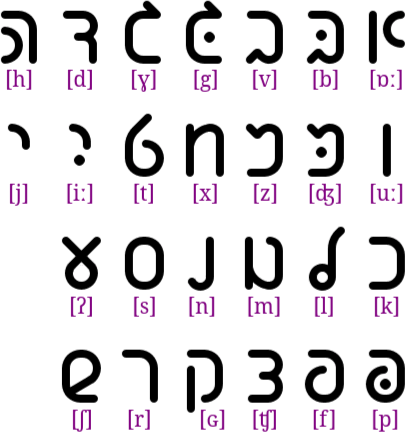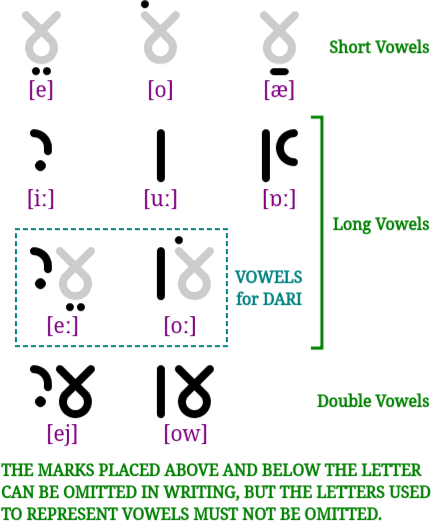The Farsi Alefbet is an adaptation of the Hebrew cursive script to write Farsi. It was devised by Punya Pranava Pasumarty to be a more straightforward way to write Farsi (Persian) as opposed to the Arabic-based abjad it uses today. This script is also an abjad, but it differs from the Hebrew script in a few ways:
The following are the letters used in Farsi Alefbet:

Each letter used here has a unique sound and vice versa, so ס is always used for the [s] sound and ש, always for [ʃ]. To this end, the letter ת has been removed in favour of using ט for the [t] sound. Some letters have slightly different sounds from their Hebrew equivalents, like זּ is used for [ʤ], צ is used for [ʧ] and ק for [ɢ].
While most consonants of Farsi Alefbet can be represented using a single letter (with or without a middle dot), there is one consonant represented using a digraph: זש for the sound [ʒ]. This has been borrowed from Yiddish orthography
The silent letters and semivowels have been repurposed in the following ways:
Note that the letters of the alefbet cover both consonants and long vowels but not short vowels, which in turn are represented by niqud marks placed above or below a letter. They can be used on any consonant letter to follow it with the their respective vowel sound, but they cannot be used on the long vowel letters. Farsi alefbet’s representation of vowels is as follows (niqud marks are shown on a grayed out ע, which can be replaced by any consonant letter):

The following is the Farsi version of Article 1 of the UDHR as written in the Farsi Alefbet (niqud marks are shown in grey since they can be omitted in writing for convenience, unless that leads to ambiguity):

تمام افراد بشر آزاد به دنیا می آیند و از لحاظ حیثیت و حقوق با هم برابرند, همه دارای عقل و وجدان می باشند و باید نسبت به یک دیگر با روح برادری رفتار کنند.
Tamâm-e afrâd-e bašar âzâd be donyâ miâyand va az lehâz-e heysiyat-o hoquq bâ ham barâbar-and. Hame dârâ-ye aql-o vejdân mibâšand va bâyad nesbat be yekdigar bâ ruh-e barâdari raftâr konand.
All human beings are born free and equal in dignity and rights. They are endowed with reason and conscience and should act towards one another in a spirit of brotherhood.
(Article 1 of the Universal Declaration of Human Rights)
Information about Persian | Latin alphabets for Persian | Phrases | Numbers | Family Words | Tower of Babel | Links | Learning materials
Bhāratalipi Unified Indian Script (BLUIS), Charunagari, Deccan Lipi, Devadeshi, Ethiofarsi, Españabugida, Farsi Alefbet, Featural Lojban Abjad, Haruf-e-Tana, Palimukhi, Neobrahmi, SEAscript, West Eurolex
Constructed scripts for: Ainu | Arabic | Chinese languages | Dutch | English | Hawaiian | Hungarian | Japanese | Korean | Lingala | Malay & Indonesian | Persian | Tagalog / Filipino | Russian | Sanskrit | Spanish | Taino | Turkish | Vietnamese | Welsh | Other natural languages | Colour-based scripts | Tactile scripts | Phonetic/universal scripts | Constructed scripts for constructed languages | Adaptations of existing alphabets | Fictional alphabets | Magical alphabets | A-Z index | How to submit a constructed script
[top]
You can support this site by Buying Me A Coffee, and if you like what you see on this page, you can use the buttons below to share it with people you know.

If you like this site and find it useful, you can support it by making a donation via PayPal or Patreon, or by contributing in other ways. Omniglot is how I make my living.
Note: all links on this site to Amazon.com, Amazon.co.uk
and Amazon.fr
are affiliate links. This means I earn a commission if you click on any of them and buy something. So by clicking on these links you can help to support this site.
[top]